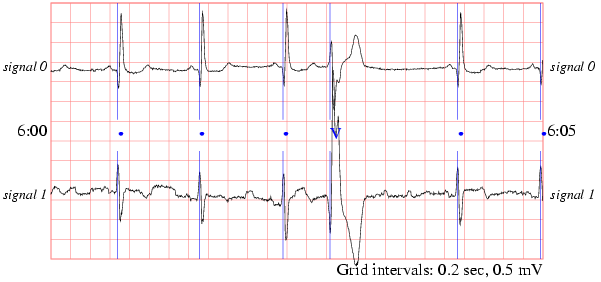The AHA Database has not been made available by ECRI for download from PhysioNet or any other site; it may be obtained only from ECRI at:
ECRI
5200 Butler Pike
Plymouth Meeting, PA 19462 USA
http://www.ecri.org/
Contact: Kate O'Rourke
<korourke@ecri.org>
A record that was excluded from the AHA Database is available for download, in both the long (record 0001) and short (record 0201) versions (see details below).

The American Heart Association (AHA), with funding from the National Heart, Lung, and Blood Institute (NHLBI), sponsored the development of the AHA Database for Evaluation of Ventricular Arrhythmia Detectors during the late 1970s and early 1980s at Washington University (St. Louis). The first portions of the AHA Database were released in 1982, and it was completed in 1985. No revisions or updates were made subsequently, although ECRI has distributed the database in several different formats.
Until about 2003, the only available portion of the AHA database consisted of 80 two-channel excerpts of analog ambulatory ECG recordings, digitized at 250 Hz per channel with 12-bit resolution over a 10 mV range. These 80 recordings, designated as the development set or series 1, are divided into eight classes of ten recordings each, according to the highest level of ventricular ectopy present:
- no ventricular ectopy (records 1001 through 1010)
- isolated unifocal PVCs (records 2001 through 2010)
- isolated multifocal PVCs (records 3001 through 3010)
- ventricular bi- and trigeminy (records 4001 through 4010)
- R-on-T PVCs (records 5001 through 5010)
- ventricular couplets (records 6001 through 6010)
- ventricular tachycardia (records 7001 through 7010)
- ventricular flutter/fibrillation (records 8001 through 8010)
The final thirty minutes of each recording are annotated beat-by-beat, although supraventricular ectopic beats are not distinguished from normal sinus beats. Two versions of the database are available: the short version includes five minutes of unannotated ECG signals prior to the thirty-minute annotated segment of each recording, and the long version includes 2.5 hours of unannotated ECG signals prior to each annotated segment. The names of the short-version records are the same as the corresponding long-version records, except that the second digit is 2 (thus record 4207 is the short version of record 4007, etc.).
At the time the AHA Database was created, a second set of 75 recordings (designated as the test set or series 2) was constructed according to the same criteria as the development set. (Only 5 recordings in the R-on-T PVC class were included in the test set). The test set was intended for evaluations without any possibility that the detectors might have been tuned (optimized) for the test data; for this reason, the test set was unavailable until about 2003. The names of the records in the test set are similar to those in the development set; the first digit indicates the class, and the second digit is 1 (for the long version) or 3 (for the short version). For example, the test set's record 6102 is a long-version record containing ventricular couplets (class 6).
Both sets of the AHA Database are now available on CDs or DVDs from ECRI (address above).
The files available here are not part of the AHA Database. The 0001.* and 0201.* files have been derived from a sample given to us in 1980 by the creators of the AHA Database. The original recording had been a candidate for inclusion in the database and was digitized and annotated using the same methods used for the AHA Database records. After the annotation process was complete, the recording was excluded from the AHA Database since it was found to contain ectopy of a higher grade than the class for which it had been chosen as a candidate.
As for the records in the AHA Database, the data consist of a 3-hour recording of two ECG signals, for which the last 30 minutes are annotated beat-by-beat. From the original data, we have prepared record 0001, containing the entire 3-hour recording, and record 0201, containing the last 35 minutes only.
The WFDB Software Package includes a set of converters that can translate between the formats used for the AHA database and the standard formats used for PhysioBank databases. These converters were used to prepare the 0001.* and 0201.* files in this directory. If you use these converters to prepare a set of AHA Database files in PhysioBank format, you can check that your files are correct by comparing their checksums with those given in the MD5*, SHA1*, and/or SHA256* files below. These have been verified using copies of the AHA Database 9-track tapes, floppy disks, CDs, and DVDs.
Name Last modified Size Description
Parent Directory -
0001.atr 2003-06-05 21:34 4.5K reference annotations
0001.dat 2003-06-05 21:33 7.7M digitized signal(s)
0001.hea 2008-04-05 18:05 98 header file
0201.atr 2003-06-05 21:44 4.5K reference annotations
0201.dat 2003-06-05 21:45 1.5M digitized signal(s)
0201.hea 2008-04-05 18:05 98 header file
ANNOTATORS 2003-06-05 23:59 31 list of annotators
DOI 2015-09-21 13:00 19
MD5SUMS 2005-07-12 20:31 391
MD5SUMS-development-set 2012-07-09 17:05 20K
MD5SUMS-test-set 2012-07-09 16:52 19K
RECORDS 2003-06-05 23:59 10 list of record names
RECORDS-development-set 2012-08-06 13:43 800 list of record names
RECORDS-test-set 2012-08-06 13:42 750 list of record names
SHA1SUMS 2005-07-12 20:31 513
SHA1SUMS-development-set 2012-07-09 17:05 24K
SHA1SUMS-test-set 2012-07-09 16:52 22K
SHA256SUMS 2007-09-18 12:36 828
SHA256SUMS-development-set 2012-07-09 17:05 35K
SHA256SUMS-test-set 2012-07-09 16:52 33K
|
If you would like help understanding, using, or downloading content, please see our Frequently Asked Questions. If you have any comments, feedback, or particular questions regarding this page, please send them to the webmaster. Comments and issues can also be raised on PhysioNet's GitHub page. Updated Friday, 28 October 2016 at 16:58 EDT |
PhysioNet is supported by the National Institute of General Medical Sciences (NIGMS) and the National Institute of Biomedical Imaging and Bioengineering (NIBIB) under NIH grant number 2R01GM104987-09.
|